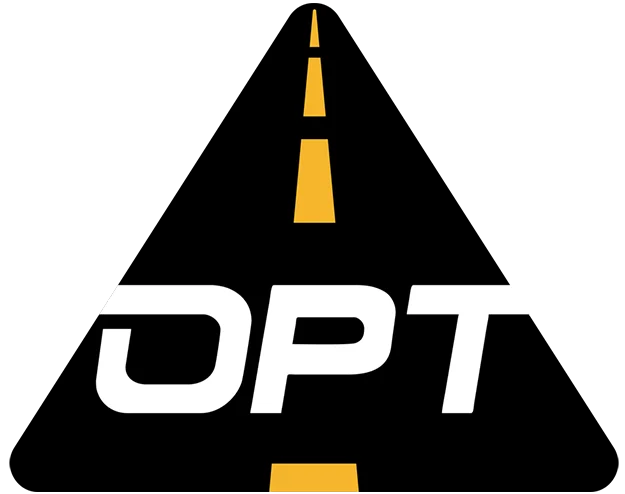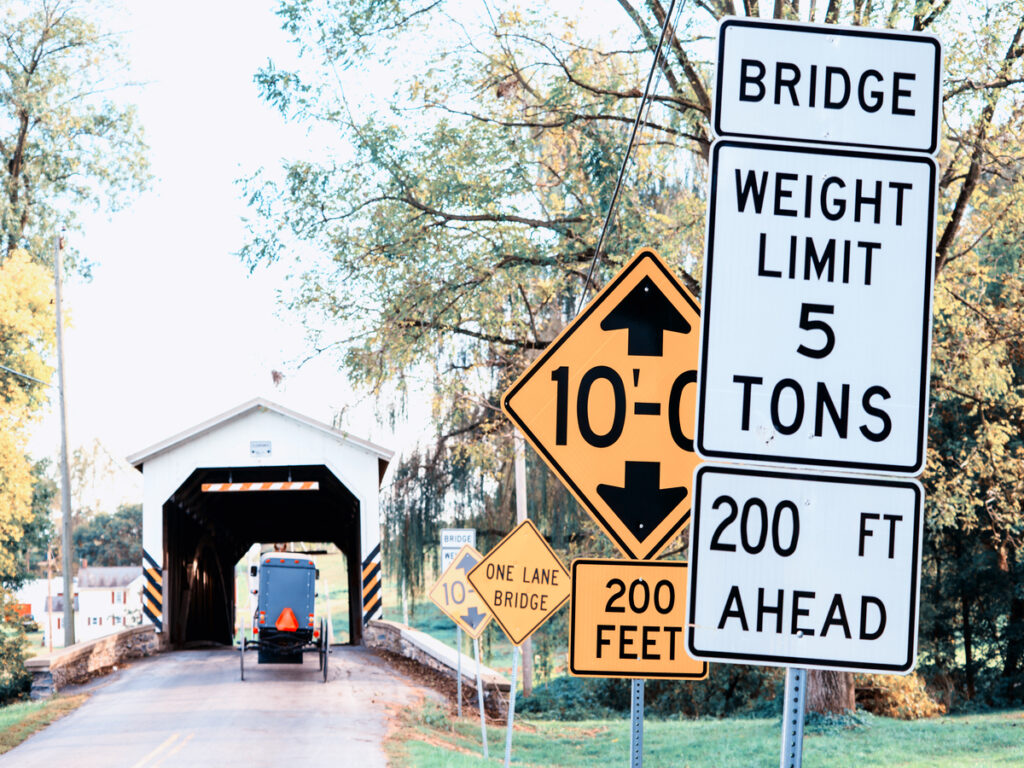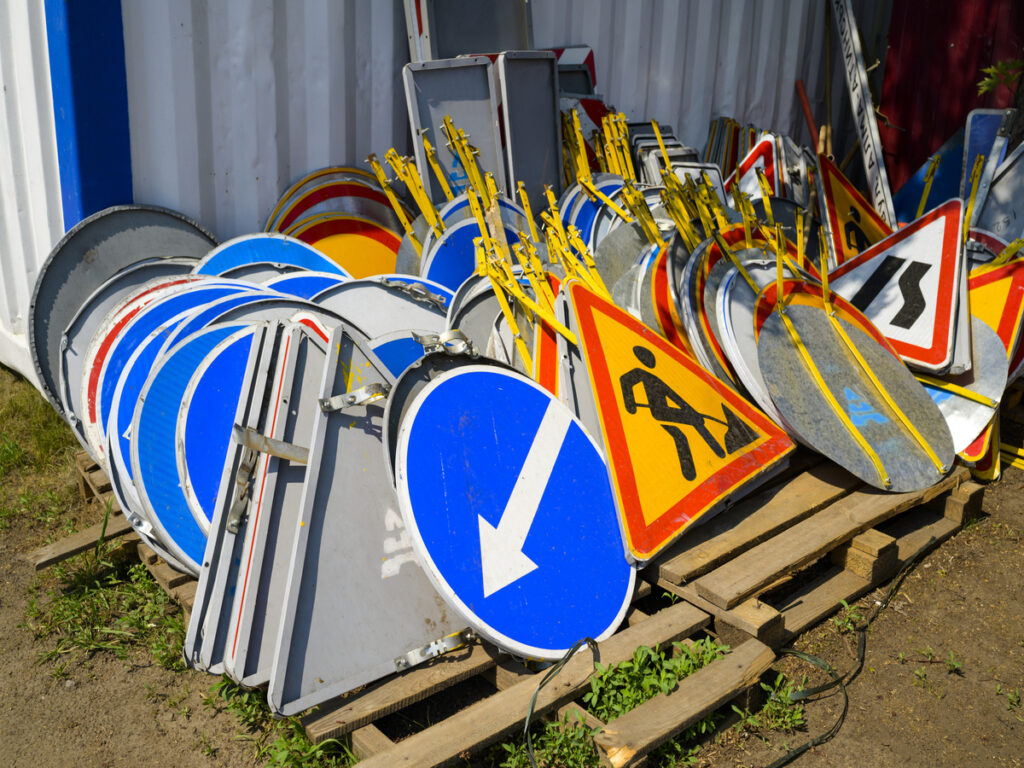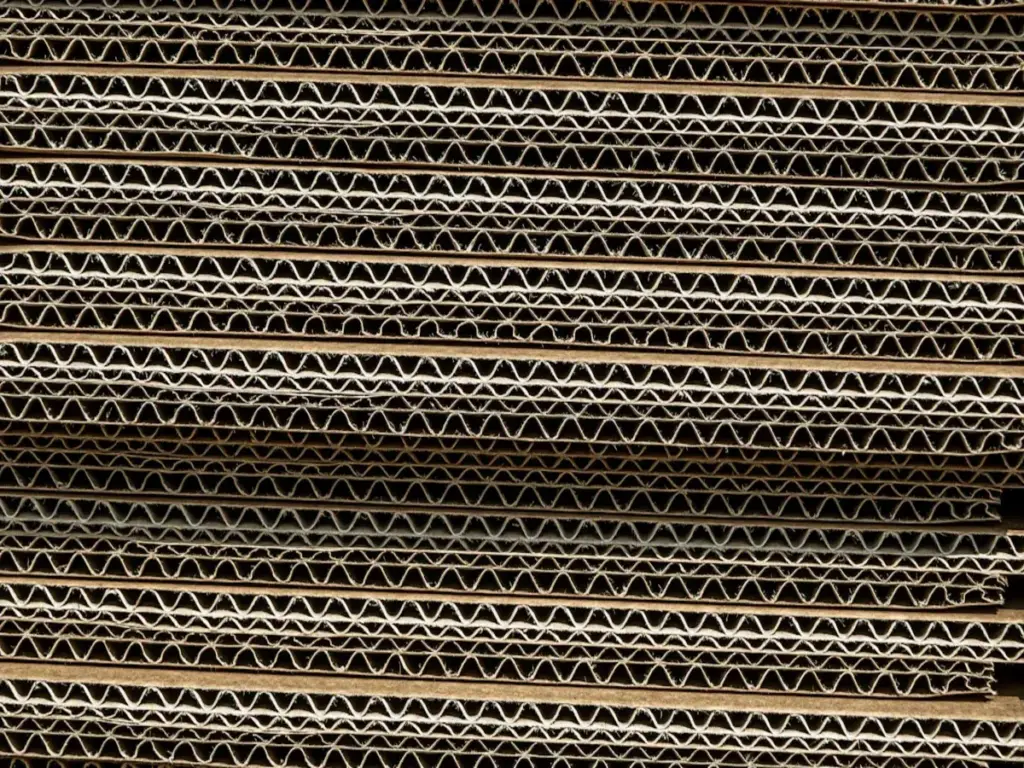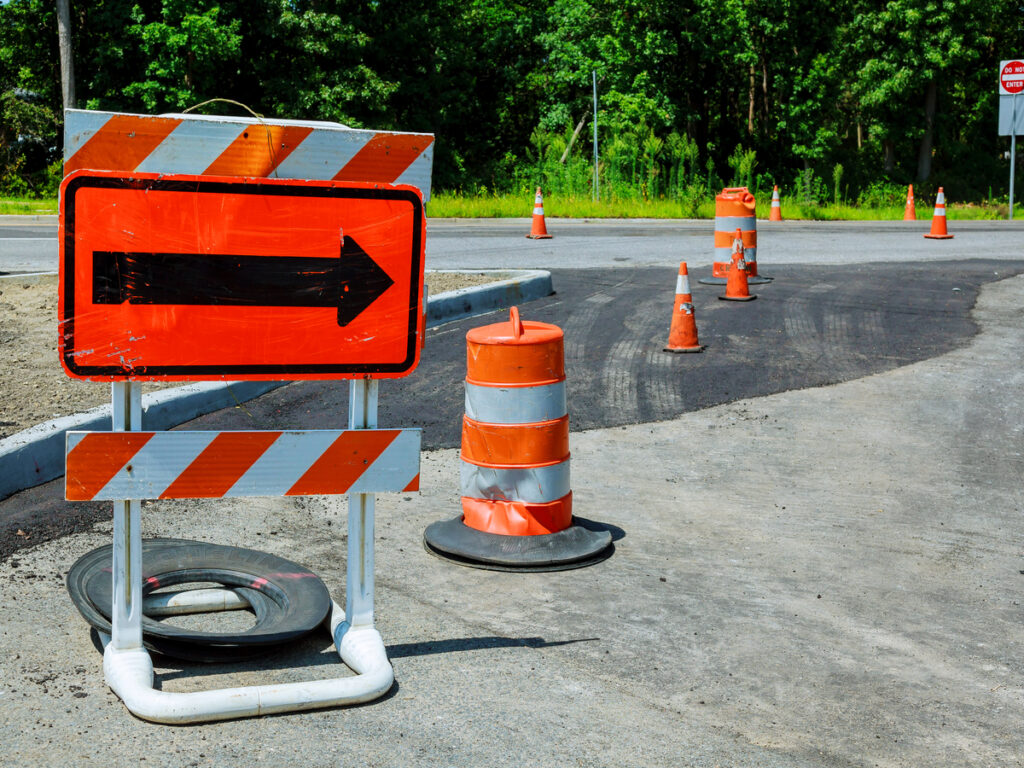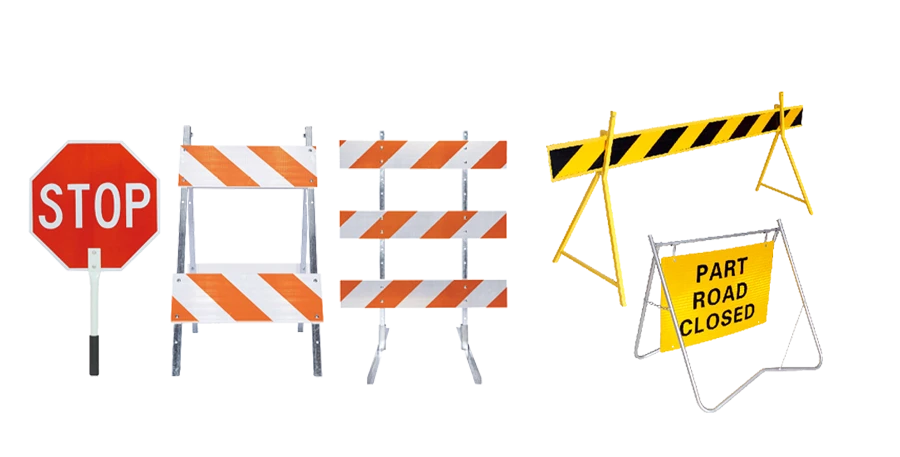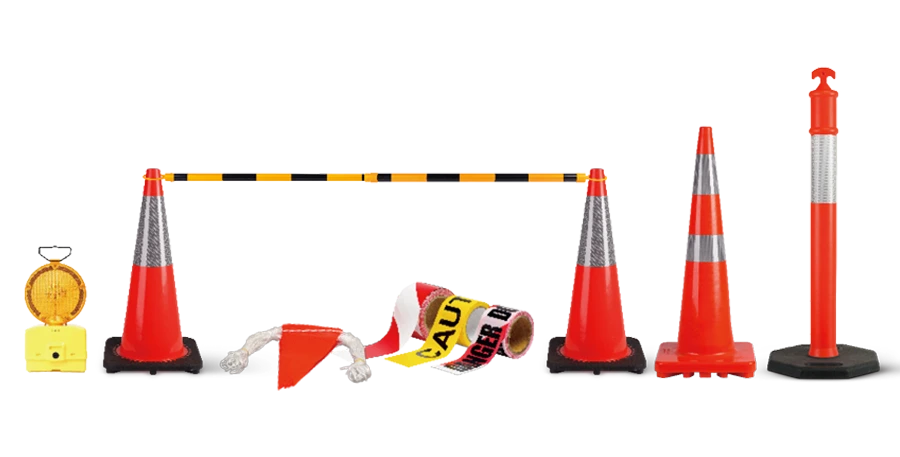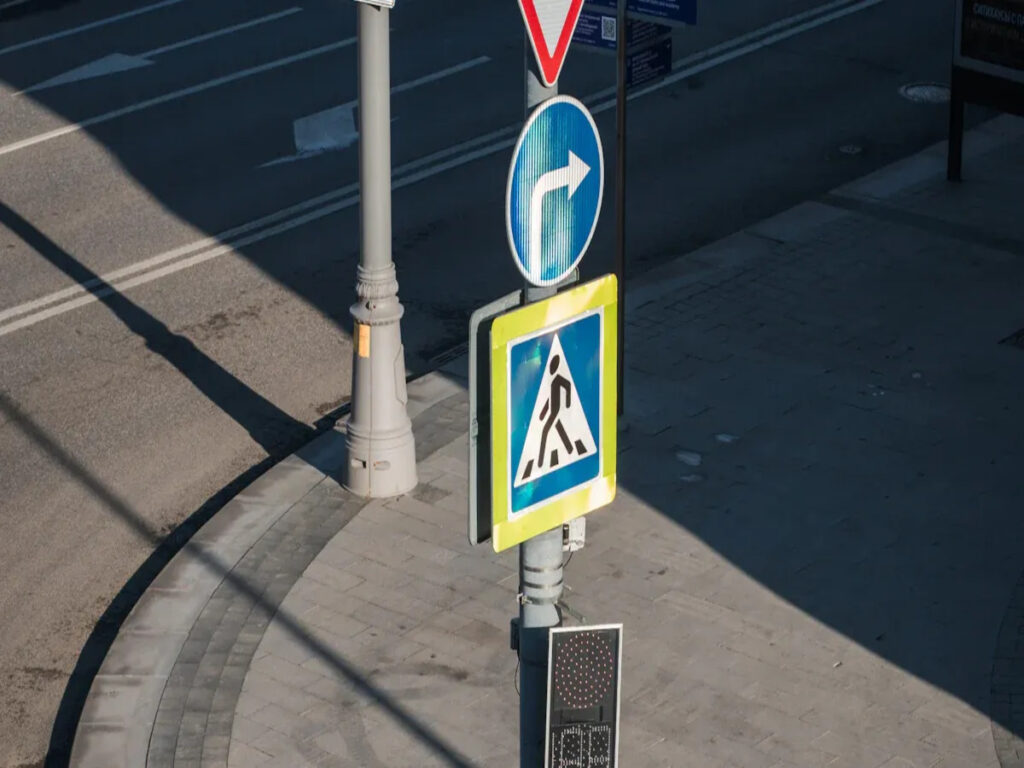
Choosing the right signs at intersections and crossings keeps people safe. Drivers and pedestrians need protection. Aux États-Unis, à propos 2.5 million accidents happen at intersections each year. Half of these accidents are very serious. Highway-rail grade crossings had 2,261 crashes in 2024. These crashes caused many injuries and deaths. Recent studies show that good cross road signs and pedestrian signals help stop crashes. They also make roads safer.
| Étude | Résultats | Recommendations |
|---|---|---|
| Zegeer et al. (1982) | Triangular signs lower turning conflicts. | Add to MUTCD for high pedestrian crash spots. |
| Robertson et Carter (1984) | Pedestrian signals cut crashes at some intersections. | Adjust signal timing for better results. |
For traffic management companies and city planners, OPTRAFIC offre une large gamme de panneaux de signalisation de haute qualité designed specifically for intersections and crossings. Depuis Signes de passage pour piétons à highway-rail grade crossing signs, OPTRAFIC ensures that your signage is compliant with safety standards and highly visible, helping reduce accidents and improve overall safety. Confiance OPTRAFIC to provide the right signs for your needs, ensuring safer roads and crossings for everyone.
Principaux à retenir
- Picking the right signs at intersections and crossings is very important for safety. These signs help stop accidents and keep drivers and people walking safe.
- There are different signs for different reasons. Regulatory signs tell drivers about rules. Warning signs let them know about possible dangers.
- Where you put signs is important. Signs need to be easy to see from far away. They should be at eye level so drivers can see them and react quickly.
- Signs need to be checked often. Agencies should look for signs that are hard to see, dirty, or broken. Cela aide à protéger les routes.
- Local needs should help decide which signs to use. Knowing how people drive in the area helps pick the best signs for each place.
Intersections vs. Passages à niveau
What Is an Intersection?
An intersection is where two or more roads meet. Some examples are T-junctions, four-way stops, et ronds-points. Drivers must decide to turn or go straight at these places. Intersections in cities can get very busy. Des panneaux clairs aident les conducteurs à savoir quoi faire. Signes d'arrêt, signes de rendement, and lane control signs show who goes first. Dans le pays, intersections need bigger signs. These signs are put farther away because cars go faster. Drivers need more time to see and react. Dans les villes, signs are smaller and closer together. This keeps things simple and easy to understand.
What Is a Crossing?
A crossing is a spot where people, vélos, or trains cross a road. There are pedestrian crossings, bike lane crossings, and railroad crossings. Each type needs special safety steps. Pedestrian crossings use signs and painted lines for walking. Bike crossings have markers for drivers and cyclists. Railroad crossings use gates, feux clignotants, et des signes d'avertissement. These keep everyone safe. Crossings in cities and the country must follow Règles Mutcd. These rules help drivers know what signs mean everywhere. Local governments can add more rules for crossings near schools, parcs, ou autoroutes. This helps protect people in busy or risky places.
Note: Intersections and crossings have different jobs for road safety. Intersections help cars move safely. Crossings protect people and bikes going across roads. Picking the right signs for each helps stop accidents and keeps people safe.
Traffic Signs and Meanings
Regulatory Signs at Intersections
Regulatory signs are important for safety at intersections. Ces panneaux indiquent aux conducteurs ce qu'ils peuvent ou ne peuvent pas faire. Each sign has its own color and shape to show a message. Red and white signs mean stop or do not do something. Black and white signs show rules like speed or lane use. Octagon shapes always mean stop. Triangle shapes mean yield. Drivers see these signs and know what to do.
Some common regulatory signs at intersections are:
- Panneau d'arrêt: Drivers must stop all the way before going. Stop signs are at many intersections where roads meet.
- Signe de rendement: Drivers slow down and let others go first. Yield signs help stop crashes by giving the right of way.
- Speed limit sign: Shows the fastest speed allowed. Drivers must follow this rule to keep roads safe.
- Turn only lanes sign: Shows which lanes let you turn. These signs help traffic move in order.
- No right/left turn sign: Drivers cannot turn in that direction. These signs stop unsafe turns.
Stop signs and yield signs are in cities and the country. Stop signs are for busy intersections. Yield signs are for places with less traffic. Traffic signs and their meanings are the same everywhere in the country. Cela aide les conducteurs à savoir quoi faire.
Warning and Pedestrian Crossing Signs
Warning signs and pedestrian crossing signs tell drivers about dangers ahead. These signs use bright colors and shapes to get attention. Warning signs are yellow or bright yellow-green and shaped like diamonds. Pedestrian crossing signs are bright yellow-green and shaped like rectangles.
| Type de signe | Couleur | Forme |
|---|---|---|
| Panneaux d'avertissement | Yellow or Fluorescent Yellow-Green | Diamant |
| Signes de passage pour piétons | Jaune-Vert Fluorescent | Rectangulaire |
Warning signs tell drivers about curves, fusion, ou d'autres dangers. Pedestrian crossing signs show where people might cross the street. These signs help drivers stop or let people go first. Stop signs and yield signs can also be near crossings for more safety. Traffic signs should be easy to see and understand. Good spots and clear signs help keep everyone safe.
Choosing Cross Road Signs
Urban and Rural Intersections
Urban intersections have lots of cars and people. Cross road signs in cities must be easy to see. Traffic engineers use speed limit sign and do not enter signs to help traffic move safely. Dans les villes, signs should be clear and at eye level. Smaller signs are good because cars go slower and streets are close. Lane control and turn restriction signs show drivers where to go. Pedestrian crossings need bright markings and signals.
Rural intersections are different. Cars go faster and drivers may not expect to stop. Cross road signs in rural places must be bigger and shine more. Speed limit signs should be far ahead so drivers can slow down. Warning signs tell drivers about intersections or dangers coming up. Flashing lights and other warning systems help when it is hard to see. SHARE THE ROAD plaques remind drivers to watch for people walking or biking. The table below lists the best ways to use signs in rural intersections:
| Type de signe | Application |
|---|---|
| Panneaux d'avertissement | Used to alert drivers of potential hazards, especially in low visibility areas. |
| Dynamic Warning Systems | Enhance visibility and awareness for drivers approaching intersections. |
| SHARE THE ROAD Plaque | Alerts drivers to the presence of non-motorized users, Améliorer la sécurité. |
| MUTCD Guidance | Provides specific sections for applicable signs for non-motorized users. |
Picking the right sign size and type helps keep everyone safe. Cities need small, frequent signs. Rural roads need bigger, brighter cross road signs.
Routes à grande vitesse
High-speed roads need special care. Les voitures roulent vite, les conducteurs ont donc besoin de plus de temps pour voir les panneaux. Bigger speed limit signs and do not enter signs warn drivers early. Putting these signs farther from the intersection helps drivers slow down. Balises clignotantes and Intersection Conflict Warning Systems (ICWS) warn drivers about dangers.
The table below shows how signs help on high-speed roads:
| Type de signe | Effectiveness in Speed Reduction | Réduction du taux d'accidents |
|---|---|---|
| 80 km/h sign | More effective than Deceleration | N / A |
| 70 km/h variable speed limit | Causes significant deceleration | 5% reduction in collisions |
| ICWS (Intersection Conflict Warning System) | Alerts drivers to conflicts | 5% réduction des accidents |
Speed limit sign placement must follow MUTCD rules. Les signes doivent être faciles à voir de loin, Même la nuit ou par mauvais temps. Do not enter signs stop wrong-way driving, which is very dangerous on fast roads. Cross road signs must use shiny materials so drivers can see them better. Engineers sometimes add extra signs or paint on the road to help drivers notice the message.
School Zones and Pedestrian Areas
Zones scolaires Besoin de soins supplémentaires. Kids might cross the street at any time. Cross road signs in school zones must be easy to see and read. School speed limit sign and do not enter signs help keep students safe. Signs in school zones are often bigger than in other places. Bright colors and flashing lights help drivers notice the crossing.
Conseil de sécurité: Always use the biggest sign allowed in school zones. Placez des panneaux là où les conducteurs peuvent les voir de loin.
Dans des endroits où les gens marchent, engineers use speed limit signs, crosswalk lines, et des lumières clignotantes. These things slow down cars and keep walkers and bikers safe. Here are some important tips for school and pedestrian areas:
- School zone signs can be bigger than MUTCD says.
- Extra care is needed to keep kids safe.
- Traffic calming and special signs like school speed limit sign and RRFBs are important.
- The smallest size for yellow rectangle signs is 5 pouces de large et 2 pouces de haut.
- Flashing lights must blink in a certain way, matching other RRFBs at the crossing.
- The downward arrow plaque should be at least 7 pieds au-dessus du trottoir.
Do not enter signs keep cars out of areas near schools. Speed limit sign placement should fit the area’s needs. Cross road signs in school zones and pedestrian areas must be checked often to make sure they work well and are easy to see.
Placement of Crossing and Pedestrian Crossing Signs
Visibility at Intersections
Putting crossing and pedestrian crossing signs in the right spots helps keep everyone safe. Traffic engineers pick where to put cross road signs by looking at the road, comme c'est facile de voir, and how many people walk there. Signs must follow rules from the city and the country. Each sign should be big and have bright colors so drivers can see it from far away. Large signs with strong colors help drivers notice crossings early, especially when it is busy.
| Ligne directrice | Description |
|---|---|
| Emplacement | Pick sign spots by road type, visibilité, and how many people walk. |
| Règlements | Follow all traffic laws for where signs go. |
| Taille et visibilité | Utiliser grand, clear signs with bright colors and easy-to-read letters. |
| Placement approprié | Put signs at intersections and places where lots of people cross. |
| Entretien | Clean and check signs often, Surtout après le mauvais temps. |
Studies show that where pedestrian crossing signs are placed can change accident numbers. If signs are easy to see and in the right place, drivers slow down and watch for people crossing. Wide roads and things that slow cars down also help stop crashes. Putting signs where people cross most often makes things safer.
Strategic Placement for Crossings
Engineers use certain distances to put crossing signs before intersections. Par exemple, stop ahead or yield ahead signs should be seen from at least 50 mètres. Merge or lane end signs need to be seen from 75 mètres. These distances give drivers enough time to slow down and keep people safe.
| Condition | Sign Legibility Distance | Typical Signs |
|---|---|---|
| UN | 50 m | Stop Ahead, Yield Ahead, Intersection Warning |
| B | 75 m | Merge, Right Lane Ends |
Extra care is needed near schools, busy city streets, and fast roads. Dans les zones scolaires, curb extensions and safe islands make crossing shorter and easier to see. Traffic lights with pedestrian recall and flashing lights help drivers notice people crossing. Better lighting at crosswalks helps drivers see kids and others. People trust leaders more when they fix safety problems near schools.
Conseil: Put pedestrian crossing signs at least 7 feet above sidewalks so everyone can see them. Use flashing lights and bright colors in risky places to warn drivers.
Compliance and Maintenance for Traffic Signs
Meeting MUTCD and Local Standards
All regulatory signs must follow strict rules. The MUTCD gives the main standards for these signs. Ces règles aident à garder les routes en sécurité pour tout le monde. They also make sure drivers understand each sign’s message. Some states use the national MUTCD for all their signs. Other states add extra rules or make their own manual based on MUTCD. Local agencies must check that every sign follows both sets of rules.
| Exigence | Description |
|---|---|
| Rétro -flectivité | Signs must shine at night so people can see them. |
| Entretien | Signs must stay clean and easy to read. |
| Remplacement | Broken signs must be changed quickly. |
| Inspection | Agencies must check signs often. |
Note: Signs that do not follow these rules can confuse drivers and cause accidents. Local rules may ask for more checks near schools or busy crossings.
Sign Maintenance and Inspection
Garder les signes en bonne forme est important pour la sécurité. Agencies must check signs often to make sure they are bright and easy to see. They should keep records of every sign and use computers in big areas. Regular checks help find faded or broken signs. Après les tempêtes, agencies should look at all signs for damage.
Common problems with signs include missing signs, faded letters, ou vues bloquées. The table below lists some issues:
| Type de violation | Description |
|---|---|
| Missing or Damaged Signs | Signs that are faded, fissuré, or missing can make safety rules unclear. |
| Improper Wording or Symbols | Signs with wrong words or symbols confuse drivers. |
| Failure to Follow ANSI/Normes OSHA | Signs that do not follow color or size rules are not safe. |
| Obstructed or Hidden Signs | Signs blocked by trees or snow cannot be seen. |
Agencies should clean signs at least two times a year. Use mild soap and a soft cloth to protect the shiny surface. Newer sign materials may need less cleaning, but all signs must be easy to see. When a sign is damaged, replace it quickly. Follow the maker’s advice for repairs and use the right letters and symbols. Seal holes on the back of signs to stop water from getting in. Dans les endroits enneigés, use clear film or move signs so snow does not cover them.
Conseil: Always check signs after bad weather. Good records and regular checks help keep every sign working well.
Erreurs courantes pour éviter
Placement Errors
Traffic managers sometimes put signs in the wrong places. These mistakes can make roads less safe for drivers and walkers. Signs need to be easy to see from far away. This gives drivers enough time to slow down or stop. Signals should be at eye level so people notice them fast. Dans les zones occupées, signals must help cyclists and walkers too. Extra signals make sure at least one sign is always seen. If one gets blocked, another is still there. Following safety rules from the country and state helps signals work right.
Common placement errors include:
- Putting signs behind trees or buildings so drivers cannot see.
- Using signs that are too small for the road.
- Placing signals too close to intersections so drivers have no time.
- Not adding extra signs in busy or risky places.
- Forgetting about clear signs for night or bad weather.
Conseil: Check sign spots often and move them if needed. This keeps sight lines clear for everyone.
Ignoring Local Needs
Not thinking about local needs when picking signs can be dangerous. If stop signs are missing, des accidents peuvent survenir. Drivers who go too fast in work zones can hurt themselves and workers. Not yielding at crossings puts people in danger. Every town has its own traffic problems and safety needs.
Strategies to address local needs:
- Use clear speed limits, Signes d'arrêt, and crosswalk signs to keep people safe.
- Follow MUTCD rules for safety and making signs easy to see.
- Put up wayfinding signs to help people find their way.
- Make special signs that match the town’s look and feel.
Note: Listen to what people say and watch how traffic moves. This helps managers pick signs that fit the area and keep everyone safe.
Picking the right signs for intersections and crossings takes planning. Traffic managers need to know what each sign means. They must put signs in good spots and follow all rules. They should:
- Use signs that do not block where people walk.
- Follow state and local rules for every sign.
- Add more signs in busy or risky places.
- Check if signs work well by looking at safety data.
- Keep signs clean and check them often.
| Program Name | Comment cela aide à garder les routes en sécurité |
|---|---|
| Railway-Highway Crossings Program | Gives money to make crossings safer and lower deaths, blessures, and crashes. |
| Highway Safety Improvement Program (HSIP) | Works on fixing roads to lower deaths and bad injuries on public roads. |
Using these steps makes roads safer for everyone.
FAQ
What is the difference between intersection and crossing?
An intersection is a point where two or more roads meet or cross each other. It is a broad term used for various junctions, such as T-junctions, four-way intersections, et ronds-points, and typically involves vehicles, piétons, and traffic control devices like stop signs or traffic lights. D'autre part, a crossing refers to a specific point where a path or road crosses another, often associated with pedestrian crossings, traverse, or bike lane crossings. While all crossings are types of intersections, not all intersections are crossings. The main difference is that crossings are more focused on the movement of pedestrians or vehicles across a road, whereas intersections generally refer to areas where roads meet or diverge.
What does the crossing sign mean?
The crossing sign typically refers to a warning sign indicating that a road or rail crossing is ahead. In the case of pedestrian crossing signs, it signals drivers to slow down and watch for pedestrians crossing the street. For railroad crossings, the sign warns vehicles of an upcoming train track where a train might be crossing the road. It is an essential safety feature for preventing accidents at critical intersections or crossings.
What is the purpose of a railroad crossing sign?
A railroad crossing sign tells people trains are coming. It warns drivers and walkers about tracks ahead. The sign helps everyone slow down or stop before the tracks. This lowers the chance of accidents with trains.
When should traffic managers use bicycle and pedestrian signs?
Traffic managers put up bicycle and pedestrian signs where lots of people walk or bike. These signs tell drivers to watch for people crossing or riding. Ils contribuent à rendre les rues plus sûres pour tous.
How does a one way sign improve intersection safety?
A one way sign shows drivers which way to go on a street. This stops confusion and keeps cars from crashing head-on. It also helps cars move better at intersections.
Who decides where to place crossing signs?
Local traffic engineers and city planners pick where crossing signs go. They look at how cars move, accident numbers, and what the community needs. Their job is to keep roads safe for everyone.
À quelle fréquence les panneaux de signalisation doivent-ils être inspectés?
Agencies need to check traffic signs two times each year. Regular checks keep signs easy to see, faire le ménage, and working well. Fast repairs or new signs help keep roads safe.
